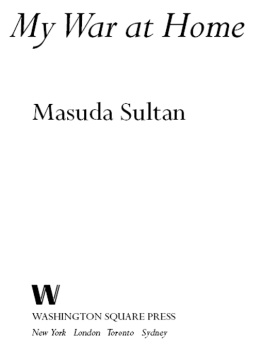Table of Contents
Acknowledgements
I am deeply indebted to my editor, Ian Leask, who, over the years, has constantly pushed me to tackle new writing projects, no matter how challenging. For this project his genius was his ability to unlock memories I had stored in the far reaches of my mind, and help me turn them into coherent stories.
To Colleen McElroy, who thought enough of my writing to award me a spot in her Creative Nonfiction Residency Program at The Loft Literary Center in Minneapolis in 1999. I am grateful for her encouragement and friendship.
To Sarah Harder, for inviting me to sit on her Executive Board at the National Peace Foundation and for the opportunity to expand my work promoting peace between Israelis and Palestinians.
To my friend, Eileen Immerman, who was there when I needed her to design a map, teach me how to cut and paste and make me look good in Photoshop.
To Ed Foreman, for his amazing ability to transform an otherwise ordinary text into something extraordinary.
And finally, to Michel, my husband of nearly 40 years. Through the best and worst of times, we have managed to always come out on top. All my love.
Lebanon Timeline
3000 B.C. - The area known today as Lebanon first appears in recorded history as a group of coastal cities and forested hinterland, inhabited by Canaanites, a Semitic people whom the Greeks call Phoenicians. Each coastal city is an independent kingdom: Tyre and Sidon are maritime and trade centers; Byblos and Berytus (Beirut) are trade and religious centers which at various times come under the control of Greeks, Egyptians, Hittites, Assyrians and Persians. In the rubble of postwar Beirut archeologists discovered ruins they believe to be from ancient Phoenicia 8,000 years ago.
B.C. - Alexander the Great captures Tyre. After Alexanders death his generals fight over Phoenicia (present-day Lebanon) for more than two centuries.
B.C. - Rome adds Lebanon to its Empire. Emperor Augustus grants Berytus colonial status and the city becomes a famous provincial school of Roman law until it is destroyed by a series of natural disasters in the mid-6th Century
634-1258 A.D. - The seeds of Lebanons religious strife and civil war in the 20th Century are planted during the Middle Ages. Christianity arrives in the 4th Century when Lebanon is ruled by Romes Eastern Empire, Byzantium. Islam is founded in 634 A.D. Muhammads successor, Caliph Abu Bakr, brings Islam to Lebanon. In the meantime, Islam splits into Shiite and Sunni. Around 1021 the Druze settle in Lebanon. The country is governed by the Umayyads, the Abbasids and finally the Mamluks in 1187 A.D. Under Muslim rule Lebanon prospered as a shipping center, producer of glass, textiles and pottery, also becoming known as an intellectual center.
1512-1840 - Rise of the Ottoman Empire which defeated the Mamluks in 1516-1517 adding Lebanon to its Empire. The Ottomans let the Maans, a local Druze family who settled in the Lebanon Mountains, rule the country until their leader Fakhr al-Din starts an independence movement at which time the Ottomans execute him. Bashir Shihab who takes his place, raises taxes and forces men to serve in the military, causing Christians and Druze to revolt.
1840-1860 - The Ottomans and British exile Bashir Shihab. As a way to squelch any ideas of independence, the Ottomans encourage Christians and Druze to hate each another. In 1860 the Druze massacre 12,000 Maronite Christians. When the Ottomans fail to stop the bloodshed, the French intervene on behalf of the Maronites.
1914-1918 - During WWI the Ottoman Empire joins forces with Germany and Austria-Hungry against the allied forces of England, France, Russia and later the U.S. At the end of the war, the Ottoman Empire collapses.
1916 - The Sykes-Picot Agreement, forged by Britain, France and Russia, carves up the Ottoman Empire, giving Britain control over Palestine and France control over the area that is now Lebanon and Syria.
1920 - France declares the formation of the state of Greater Lebanon, knitting together Mt. Lebanon with the regions of Beirut, Tripoli, Sidon, Tyre, Akkar and the Bekaa Valley.
1941 - During WWII British and Free French armies invade Lebanon and capture Beirut from Vichy French forces.
1943 - Lebanon gains its formal independence from France and the last French troops withdraw in 1946.
1948 - Creation of the state of Israel. A Palestinian exodus of displaced persons ensues, flooding Lebanon and Jordan with refugees.
1958 - First Lebanese civil war as Muslims rally to pan-Arab calls by Egyptian President Nasser. U.S. President Eishenhower sends 15,000 Marines to Beirut to stabilize the situation.
1964 - Arab heads of state establish the Palestine Liberation Organization (PLO) in Cairo.
1969 - Yasser Arafat elected chairman of the PLO
1970 - PLO guerrillas driven from Jordan. They set up headquarters in Beirut and increase their raids into Israel from South Lebanon. Frequent clashes between Israeli forces and the PLO unsettle the country and particularly Beirut where the PLO sets up its own fiefdom in the Beirut refugee camps.
1975 - Coupled with the Palestinian problem, Muslim and Christian differences intensify with the Muslims dissatisfied with what they consider an inequitable distribution of political power sharing and social benefits.
1975 - After shots are fired at a church, a busload of Palestinians are attacked by Christian forces. These two incidents are regarded as the spark which touches off the civil war. Palestinians join forces with the leftist-Muslim side and fighting spreads across Beirut.
1976 - Civil war intensifies. Christians massacre Palestinian inhabitants of Karantina and Tel el-Zaatar; Palestinians massacre Christians in Damour. Syrian troops enter the country at the request of the Christians.
1978 - Israeli Army invades South Lebanon. UN forces (UNIFIL) sent to patrol South Lebanon. Israel forms proxy Lebanese militia (South Lebanon Army) in occupation zone. Syrians launch major attack on Christian neighborhoods in Beirut.
1980-1981 - Increase in hostilities with Israel and Israeli-backed Christian militias fighting the Syrians in the Bekaa Valley, Sannine and Beirut.
1982 - Israeli army, led by Ariel Sharon, invades Lebanon, occupies Beirut and besieges the city for 72 days with heavy bombing. Christian Kataeb leader Bachir Gemeyal is assassinated after his election as Lebanons President. Christian Kataeb militiamen massacre thousands of Palestinians in the Sabra-Chatilla refugee camp in Beirut while Israeli soldiers drop flares to illiminate the camp. U.S., French and Italian forces arrive in Beirut to take part in Multinational Peacekeeping force.
1982 - PLO expelled from Lebanon. Arafat sets up his headquarters in Tunisia.
1983 - U.S. Beirut Embassy destroyed by Islamic Jihad suicide bomber. U.S. and French military headquarters razed by Islamic Jihad suicide bombers slaughtering more than 300 servicemen.
1984 - Multinational force evacuates Beirut after collapse of Lebanese government army which resulted when the Shiite Muslims and Druze in West Beirut launched a revolt against the Lebanese Army.








